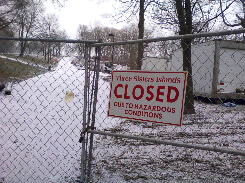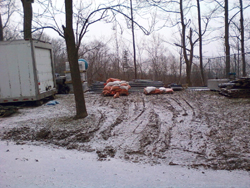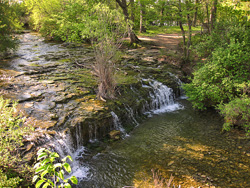State Parks Not Complying With Environmental Impact Law
By James Hufnagel & Frank Parlato
Are they breaking the law or not?
The New York State Office of Parks, Recreation and Historic Preservation (State Parks) appears to be violating the State Environmental Quality Review (SEQR) Act in its implementation of the Niagara Falls State Park Landscape Improvements Plan, presently taking place on Goat Island in the Niagara Falls State Park.
The violation is as follows: New York's SEQR Act requires all state and local government agencies to “consider environmental impacts” and, according to the state’s Department of Environmental Conservation (DEC) website, “these agencies must assess the environmental significance of all actions they have discretion to approve, fund or directly undertake."
This means that State Parks is not above environmental laws.
Whenever a state or local government undertakes a proposed action, such as constructing a building, bridge or highway, a "lead agency" must be designated. The lead agency is usually that which is directly performing the action. In the case of the Niagara Falls State Park plan, that lead agency is State Parks.
However, the required environmental assessment has not been done.
If you go for a walk around Goat Island near Three Sisters Islands, you will find plenty of reasons to wonder why that is. A large area has been cordoned off by a chain link fence, large sections of which have been scraped bare by heavy equipment; extensive plastic barriers haven been erected to reduce run-off sedimentation to the waterway; trees have been cut down, and grassy parkland has been paved over with new parking lot. Most significantly, the Niagara River tributary that separates Goat Island from the first of the Three Sisters Islands, within mere feet of the Falls itself, has been completely blocked by a ramp made of stone and dirt to provide access by heavy equipment to the islands.
By what standards are these not environmental impacts?
The final plans include new railings, new benches, new paving, new drainage systems, new street lights, new curbing, new trolley stops, and a new concessions plaza for Delaware North.
Don't any of these major changes to the park warrant an Environmental Impact Statement (EIS)? Renovation of the Observation Tower alone 10 years ago warranted preparation of an EIS, so why not this project?
New York State law, according to DEC’s own website, requires that if an action “is determined not to have significant adverse environmental impacts, a determination of non-significance (Negative Declaration) is prepared. If an action is determined to have potentially significant adverse environmental impacts, an EIS is required."
If it's determined that there is an impact, the EIS must examine ways to avoid or reduce adverse environmental impacts. It should include an analysis of all reasonable alternatives to the action.
The process is designed to encourage communication among government agencies, project sponsors and the general public, according to law.
In an amazing display of hubris, State Parks spokesman Randy Simons dismisses the need to follow environmental laws at Niagara Falls State Park, in his response to our inquiry in this matter. If his answer is indicative of how our government agencies regard the SEQR Act, then the majority of environmental laws in New York State are toothless.
As for “SEQRA compliance,” Simons wrote to the Reporter: “State Parks reviewed each project prior to initiating the construction bidding process and classified them as Type II actions, meaning they do not require any environmental review under SEQRA. Type II actions include projects to repair, replace, rehabilitate, and reconstruct existing structures and facilities, repave existing roadways, and maintain existing landscapes and natural growth… As additional projects are advanced in the future, each project will be reviewed prior to construction for (whether or not State Park will seek) SEQRA compliance.”
This rationalization provides a big enough hole to float a boat through.
A key question: Do the so-called improvements on Goat Island collectively, not one by one, have "significant adverse environmental impacts," or not?
If the potential is there a determination must be made. If there is a significant impact, then a Draft EIS must be prepared, public hearings held and public comments accepted. If not, the agency is authorized to issue a "negative declaration."
Where is that “negative declaration?”
This is where State Parks gets hung up by its own paper trail.
We'll start with the State Parks' application to the Niagara Greenway Commission for $25 million in Greenway funds to pay for the Niagara Falls State Park renovations: According to Simons' response, "SEQR Compliance - Niagara Falls State Park is part of the New York State park system and (State Parks) has jurisdiction over the property and will serve as the Lead Agency. The department’s Environmental Management Bureau will prepare environmental reviews and assessments for each of the individual projects."
But, State Parks did not prepare environmental reviews or assessments, and there is no mention of a negative declaration.
As a way of quite cleverly avoiding environmental laws, they instead broke up the $25 million project into many small individual ones in order not to have to do a proper environmental review on the project as a whole.
Also, according to the DEC website concerning SEQR law: "Segmentation of an action into components for individual review is contrary to the intent of SEQR."
State Parks is clearly in violation of the spirit, if not the letter of the law.
The Niagara Falls State Park Landscape Improvements Plan was released less than a year ago. There was no environmental review and no Draft Environmental Impact Statement. The sole mention of an EIS concerns one attached to the 1982 Master Plan for Niagara Falls State Park. That was more than 30 years ago.
The most probable reason for blatantly ignoring environmental law is that State Parks does not want to hold the public meetings required to comply with the environmental (SEQRA) laws of this state. To escape facing the public, they broke a large project into little pieces, offering them separately. “It is only a bunch of minor repair projects. Oh, we are only replacing turf here, and blocking the tributary there to rehabilitate over yonder. No need for an EIS here!”
It is the entirety of the project, wherein $25 million will be spent primarily to aid the business enterprises of the park, that should be studied, not little pieces of it.
Of course, we understand that State Parks would like to break this inconvenient law if it can. It can hardly want the put-upon citizens of Niagara Falls coming to required public hearings and starting to think they have a say with regards to the exploitation of the natural wonder and the diversion and sequestration of millions of tourists within its confines. After all, the people of Niagara Falls, particularly the business owners in the city, are their competition.
The last time State Parks held a public meeting on the stewardship of Niagara Falls State Park was 1999, gathering comments on the refurbishment of the Observation Tower. Other than that, the last two times State Parks interfaced with the public, the South Parkway scoping session of 2009 and Gov. David Paterson’s town hall meeting that same year, a near riot broke out as citizens loudly and publicly denounced the agency that has impoverished this city by hijacking the eight million tourists a year who visit and spend their vacation dollars in the park, bypassing the city of Niagara Falls as if it didn't exist.
When Western District Parks Director Mark Thomas stood up at Gov. David Paterson's town hall meeting and spoke to the crowd of how State Parks tried to partner with the city, the audience of 300 booed him heartily in front of the governor.
The Niagara Falls Reporter wants to know why State Parks is being permitted to make drastic changes to the Niagara Falls State Park without an environmental impact statement and without the required public hearings.
Stay tuned.
Against the law?
|


